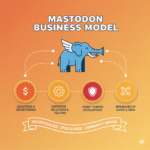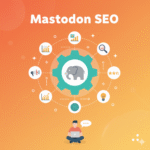Social media has changed dramatically in the last few years. Many brands feel overwhelmed by algorithm shifts, rising ad costs, and decreasing reach on the big networks. That’s why more creators, small businesses, and even large organizations are exploring Mastodon a decentralized, community-focused social network that works very differently from platforms like X (formerly Twitter), Facebook, or Instagram.
If you’re curious about how to market on Mastodon effectively or even wondering whether it’s worth your time this guide will help. I’ll explain everything in simple language, break down real strategies you can actually use, and help you understand how to build genuine visibility without feeling salesy or spammy.
Let’s dive in.
What Makes Mastodon Different from Other Social Platforms?
Before we talk strategy, it’s important to understand why Mastodon isn’t just “another social app.” Its structure changes how marketing works.
Mastodon is decentralized
Unlike Twitter or Meta platforms, Mastodon isn’t owned by one company. Instead, it’s made up of thousands of independently run servers (called instances). Each one has its own rules, culture, and community.
Think of it like email:
- Gmail, Yahoo, and Outlook are all different providers.
- But anyone with an email address can message anyone else.
That’s how Mastodon works.
There are no ads or algorithmic feeds
Your posts don’t get boosted or buried by algorithms. There’s no “pay to win” model. Content spreads based purely on relevance, engagement, and relationships.
People come for conversations, not hype
Mastodon users dislike aggressive self-promotion. They prefer:
- meaningful discussions
- open-source culture
- constructive community behavior
- transparency
- authenticity
As a marketer, this means you must shift from “broadcast mode” to “community mode.”
Who Should Use Mastodon for Marketing?
Mastodon is not ideal for every brand, but it’s perfect for those who thrive in niche communities.
Great fit for:
- tech startups
- open-source tools
- writers, journalists, researchers
- climate-focused or social-impact projects
- indie game developers
- artists and designers
- educators
- privacy-focused companies
- nonprofits and mission-driven brands
May not get strong ROI:
- high-volume e-commerce brands
- broad lifestyle influencers
- brands using heavy ad-driven growth
- companies that rely on algorithm-based virality
Mastodon rewards depth over scale. If your brand values genuine connections, community loyalty, and thoughtful engagement, you’ll feel at home here.
Choosing the Right Mastodon Server (Instance)
Where you host your account shapes your visibility and audience. Your server doesn’t limit who can see your posts, but it affects:
- who you appear next to in local timelines
- what kind of culture your content is exposed to
- how discoverable you are
- moderation rules that apply to you
Types of servers to consider:
1. General servers
Examples include mastodon.social or mstdn.social.
These are big, diverse, and active, but competition for attention is also higher.
2. Topic-specific servers
These can be communities around:
- art
- science
- writing
- gaming
- privacy
- technology
- activism
- regional cultures
- academic fields
If your niche matches the server’s focus, you’ll naturally attract users who care about your content.
3. Professional or industry servers
Some industries host their own Mastodon instances (journalism, coding communities, universities, open-source collectives).
If your brand aligns with these, they can offer highly targeted exposure.
How to choose:
Ask yourself:
- Where would my ideal customer hang out?
- Which communities align with my brand values?
- Do I want the largest audience or the most relevant one?
Tip: You can move servers later without losing followers.
Setting Up Your Profile for Trust & Visibility
Mastodon users are cautious of brands, so building trust from the start matters.
Profile Essentials:
- A clear, friendly bio (not salesy)
- A real person’s name or a transparent brand handle
- A recognizable profile photo or logo
- A brief mission statement
- Links to your website or newsletter
Add verification links
Mastodon allows link verification through HTML tags on your website. This helps prove authenticity, especially useful for businesses or organizations.
Pin an introduction post
A pinned intro helps your profile feel more human. Include:
- Who you are
- What you do
- What topics you talk about
- Why you’re on Mastodon
How to Create Content That Works on Mastodon
Here’s the golden rule:
Content that works on Twitter won’t automatically work on Mastodon.
Mastodon favors thoughtful, conversational content—not clickbait, not viral hacks, not sales posts.
Types of posts that perform well:
1. Insightful commentary
Share genuine expertise on your niche.
Example: “Why small businesses struggle with data privacy—and how to fix it.”
2. Behind-the-scenes updates
People love transparency.
Share product development updates, team moments, early sketches, experiments.
3. Long-form microblogs
You have up to 500 characters (more on some servers), so you can write richer posts than on Twitter.
4. Questions that spark discussion
Ask about the community’s experience:
“What’s the biggest challenge you face with open-source adoption?”
5. Community-first promotional content
Promotion is okay—just make it helpful.
Example: “We’re testing a new feature for writers. Want to try it and give feedback?”
6. Boosts instead of self-promotion
Boosting others builds goodwill and visibility. Mastodon rewards mutual support.
7. Content from real people
Posts from a founders’ or team members’ personal accounts often outperform brand-only accounts.
The Right Way to Promote Your Brand on Mastodon
Marketing on Mastodon is subtle. The community dislikes aggressive sales tactics. The trick is providing value first, visibility second, promotion third.
Effective promotional strategies:
1. Solve problems publicly
Instead of pitching, share tips, examples, and insights.
People become curious and check your profile naturally.
2. Share product updates as conversations
Ask for opinions, feedback, or feature requests.
3. Host discussions, not campaigns
Mastodon loves thoughtful dialogue:
- Ask for advice
- Share case studies
- Invite questions
- Launch collaborative threads
4. Use “content islands”
Create recurring themes like:
- “Tip Tuesday”
- “Privacy Mythbusters”
- “Open-Source Spotlight”
This builds reliability and habit.
5. Engage deeply with comments
Thoughtful replies build more visibility than posting frequently.
Growing Your Audience Without Algorithms or Ads
Since Mastodon has no recommendation algorithm or ad boosting, growth happens through community engagement.
Growth strategies that work:
1. Interact in local timelines
Your server’s local feed is one of the easiest places to gain early traction. Join conversations, boost others, and welcome newcomers.
2. Use hashtags intentionally
Hashtags are critical on Mastodon because there’s no algorithm to categorize content automatically.
Use 2–5 relevant hashtags per post:
- #Marketing
- #OpenSource
- #SmallBusiness
- #Art
- #Climate
- #Tech
Research what hashtags your audience already follows.
3. Participate in community events
Mastodon has weekly communal hashtags like:
- #FollowFriday
- #MastoArt
- #FediScience
- #TechTuesday
These help you reach new people.
4. Boost others generously
Boosting is the Mastodon version of retweeting. But on Mastodon, boosting others often leads to them boosting you.
5. Join Mastodon-focused groups (a.k.a. “federated groups”)
These are accounts that repost content from everyone who mentions them. They help you reach audiences across different servers.
Building Long-Term Relationships (The Core of Mastodon Marketing)
The heart of Mastodon strategy is building trusted relationships, not fast reach.
Ways to build long-term loyalty:
1. Be a reliable voice
Post consistently about topics that matter to your audience.
2. Provide deep, meaningful insights
People follow accounts that make them think, not just scroll.
3. Show your human side
Share:
- challenges
- lessons learned
- company updates
- personal reflections
- progress stories
4. Celebrate others
Highlight community members, creators, and brands you admire.
5. Reply thoughtfully, not passively
A 50-word comment is more powerful than a new post.
Mistakes to Avoid on Mastodon
Many brands join Mastodon, post like they do on Twitter, get ignored, and quit. Avoid the common pitfalls:
1. Using Mastodon like a megaphone
People dislike one-way broadcasting.
2. Overusing hashtags
Stick to relevant ones. Don’t spam.
3. Automation across platforms
Crossposting generic content from Twitter or Facebook looks lazy and disrespectful.
4. Being overly promotional
It’s okay to talk about your product—just don’t make every post a pitch.
5. Not engaging
You can’t grow here without conversations.
6. Joining the wrong server
Choose one aligned with your values and audience.
Advanced Strategies for Brands and Creators
Once you’re comfortable with the basics, try these advanced tactics.
1. Start your own Mastodon server
This works well for:
- brands
- communities
- creators with large audiences
Benefits:
- full control over rules
- branded domain
- built-in community culture
- better content discoverability for members
2. Build content series
Examples:
- “Daily Privacy Tip”
- “Open-Source Case Study”
- “Marketing Lessons from My Startup Journey”
Series help you become a go-to resource.
3. Collaborate with other accounts
You can create:
- joint threads
- shared discussions
- cross-boost exchanges
- community Q&As
4. Use Mastodon as a market research tool
Ask the community for:
- feature ideas
- naming suggestions
- feedback on prototypes
People love participating.
5. Funnel followers into owned channels
Mastodon is great for nurturing, but your long-term goal is to guide people to:
- your website
- your newsletter
- your product
- your community forum
But do it gently, never pushy.
How to Measure Success on Mastodon
Because Mastodon lacks ad analytics, success looks different.
Meaningful metrics include:
- quality of conversations
- DM requests for help
- link clicks (tracked via UTM codes)
- boosts and bookmarks
- repeat engagement from the same followers
- newsletter conversions
- positive sentiment
- community collaborations
These are deeper forms of success than vanity metrics like likes or follower counts.
Example Mastodon Marketing Workflow (Simple & Practical)
Here’s a weekly template any brand or creator can follow:
Monday
Share a thoughtful post or micro-essay with 2–3 hashtags.
Tuesday
Publish a tip, resource, or tutorial.
Wednesday
Engage in local timelines and boost others.
Thursday
Share a behind-the-scenes update or work-in-progress.
Friday
Participate in #FollowFriday and highlight other creators.
Weekend
Light conversations, community engagement, or long-form reflections.
You don’t need to post constantly. You just need to show up consistently.
Conclusion: Mastodon Marketing Is About People, Not Algorithms
If you want fast virality, Mastodon isn’t the place.
If you want genuine conversations, community trust, and long-term brand loyalty, Mastodon is one of the best platforms you can invest in.
The key mindset shift is this:
On Mastodon, you don’t market to people. You market with people.
Success comes from:
- authenticity
- value
- meaningful dialogue
- thoughtful content
- participating in community culture
- being human
If you embrace Mastodon’s decentralized, people-first approach, you’ll not only grow an audience—you’ll build a network of supporters, collaborators, and true fans.
Discover more from PratsDigital
Subscribe to get the latest posts sent to your email.


Pingback: Mastodon SEO: A Complete Guide to Boosting Discoverability on the Fediverse - PratsDigital